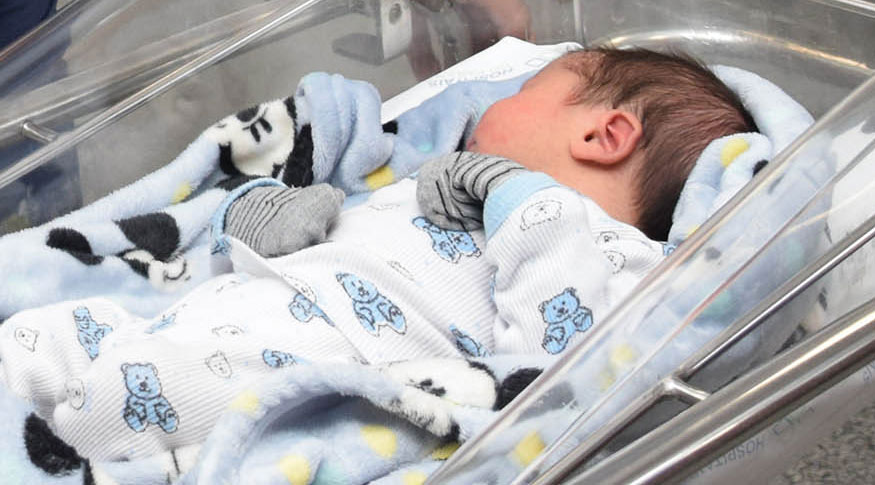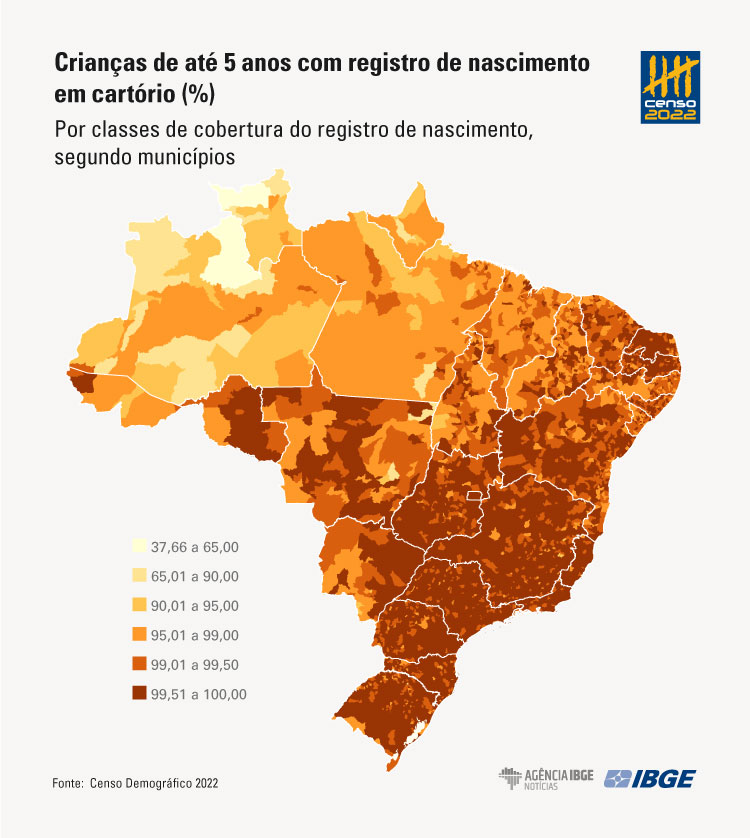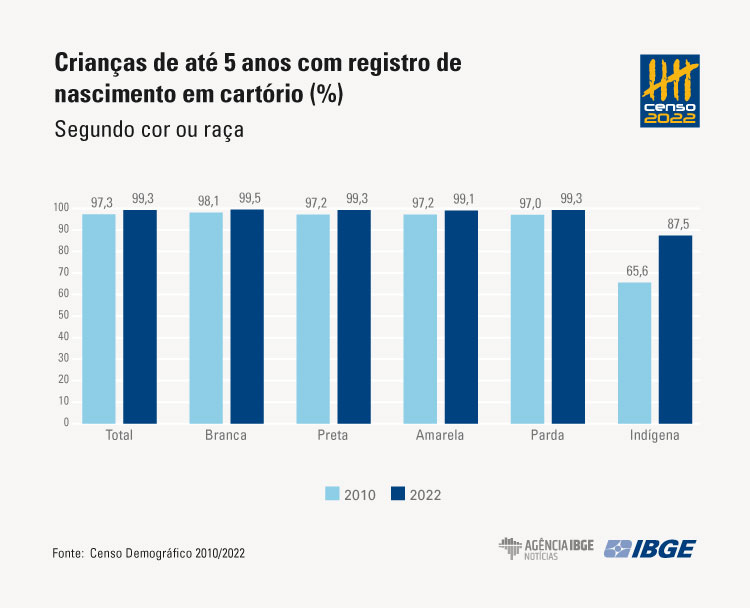2022 Census
2022 Census: 99.3% of children up to 5 years have birth registration in civil registry office
August 08, 2024 10h00 AM | Last Updated: August 09, 2024 04h14 PM
Highlights
- According to information from the 2022 Population Census, birth registrations in civil registry offices covered 99.3% of children aged up to 5 years. This percentage had been 97.3% in the 2010 Census.
- Among children under 1 year, the percentage rose from 93.8% in 2010 to 98.3% in 2022. For those aged 1 year, the proportion changed from 97.1% to 99.2%, whereas the rate advanced from 98.2% to 99.5% in the aggregate of persons between 2 and 5 years.
- While white, black, yellow and brown persons reported percentages equal to or higher than 99.0%, the proportion of persons of indigenous color or race up to 5 years of age with birth registrations recorded in civil registry offices was 87.5% (increase of 21.9 percentage points between Censuses).
- Among the regions, the North Region (97.3%) was the region that showed the lowest percentage, yet it recorded the biggest increase between Censuses, of 4.7 percentage points. The same logic was followed by the Northeast Region, with the second lowest percentage (99.3%) and the second biggest advance in the period (2.4 p.p.). In 2022, the South and Southeast regions reported 99.6%, whereas the Central-West registered 99.4%.
- Among the children in the age group under 1 year, the coverage hit 94.2% in the North, 97.8% in the Northeast, 99.1% in the Central-West, 99.4% in the Southeast and 99.5% in the South.
- Twenty-four out of 27 Federation Units already hit at least 98% of birth registrations registered in civil registry offices;
- The lowest percentages among the Federation Units were reported in Roraima (89.3%), Amazonas (96.0%) and Amapá (96.7%);
- The number of municipalities that hit 100% of children aged up to 5 years with birth registrations in civil registry offices changed from 624 (11.2%) in 2010 to 1,098 (19.7%) in 2022. On the other hand, the number of municipalities with a coverage lower than 95% dropped from 441 (7.92%) to 65 (1.17%) in the same period.

Data from the 2022 Population Census show that 99.3% of children aged up to 5 years had birth registrations in public registry offices. This percentage had been 97.3% in the 2010 Census. The coverage of birth registrations recorded in public registry offices increased 21.9 percentage points (p.p.) among persons whose color or race was self-declared as indigenous: from 65.6% in 2010 to 87.5% in 2022.
The information was published today (8) by the IBGE in the release "2022 Population Census: Birth Registration: Population Results." The release event occurs today, at 10am, at the headquarters of the Weights and Measures Institute of Amazonas (IPEM/AM) in the Industrial District of Manaus (AM). The Digital IBGE will broadcast live.
In the 2022 Census, the theme birth registration was treated with some changes when compared with the 2010 Census. The age range of interest was reduced from persons aged up to 10 years to persons aged up to 5 years whose births had been registered in civil registry offices.

Birth registrations of children under 1 year of age grows 4.5 percentage points and reaches 98.3%
In the analysis by age, records of children under 1 year, with 1 year and between 2 and 5 years were reigstered.
The increase of 4.5 p.p. stands out for birth registrations of children under 1 year of age between the 2010 Census (93.8%) and the 2022 Census (98.3%). Among children aged 1 year, the proportion changed from 97.1% to 99.2%, whereas the rate advanced from 98.2% to 99.5% in the aggregate of ages between 2 and 5 years.
Birth registrations of indigenous children hit 87.5% in 2022, a growth of 21.9 percentage points
While white, black, yellow and brown persons reported percentages equal to or higher than 99.0%, the proportion of children of indigenous color or race up to 5 years of age with birth registrations recorded in civil registry offices was 87.5%.

The 2022 Population Census investigated the existence of birth registrations registered in civil registry offices ofr children aged up to 5 years. In the absence of the civil registration obtained in civil registry offices, it was possible to opt for Administrative Registrations of Indigenous Births (RANIs), only available for indigenous children. In 2022, 5.7% of persons of color or race indigenous in this age range had a RANI In the 2010 Census, 24.5% had RANIs.
North Region remains with the lowest coverage, though it was the region that mostly advanced
The North Region (97.3%) was the region that showed the lowest percentage of children aged up to 5 years with civil birth registrations, yet it recorded the biggest increase between Censuses, of 4.7 percentage points. The same logic was followed by the Northeast Region, with the second lowest percentage (99.3%) and the second biggest advance in the period (2.4 p.p.). In the 2022 Census, the South and Southeast regions reported 99.6%, whereas the Central-West registered 99.4%.
Among the children in the age group under 1 year, the coverage hit 94.2% in the North, 97.8% in the Northeast, 99.1% in the Central-West, 99.4% in the Southeast and 99.5% in the South.
"In all the regions, children declared as indigenous color or race appear with the lowest percentage of birth registrations in civil registry offices, especially the North Region, which has the biggest population of indigenous color or race and the percentage was 81.3%," highlights José Eduardo Trindade, an analyst of the survey.
Twenty-four out of 27 Federation Units already hit at least 98% of birth registrations
The data analysis by Federation Unit in 2022 shows that the lowest percentage of children aged up to 5 years registered in civil registry offices was recorded in Roraima, adding up to 89.3%. Amazonas (96.0%) and Amapá (96.7%) complete the list of the three states with the smallest coverages. In the other Federation Units, the percentage of registered children at the same age range was higher than 98%, highlighted by the Southeast and South regions and by Rondônia, Rio Grande do Norte, Goiás, Federal District, Bahia and Paraíba, recording more than 99.5% of coverage.
Rio Grande do Sul also stands out, as 42.1% of its municipalities hit 100% of children aged up to 5 years registered in civil registry offices, followed by Santa Catarina (30.5%) and Minas Gerais (30.0%).

The number of municipalities that hit 100% of children aged up to 5 years with birth registrations in civil registry offices almost doubled in 12 years, changing from 624 (11.2%) in the 2010 Census to 1,098 (19.7%) in 2022. On the other hand, the number of municipalities with a coverage lower than 95% dropped from 441 (7.9%) to 65 (1.2%) in the same period.
According to the 2022 Census, the municipalities with the lowest percentages were: Alto Alegre (37.7%) and Amajari (48.1%),both in Roraima, and Barcelos (62.5%) in Amazonas.
| Municipality | Total number of persons up to 5 years | Percentage with registration in civil registry office (%) |
|---|---|---|
| Alto Alegre (RR) | 3638 | 37.7 |
| Amajari (RR) | 2461 | 48.1 |
| Barcelos (AM) | 2838 | 62.5 |
| Iracema (RR) | 1305 | 72.5 |
| Pedra Branca do Amapari (AP) | 1961 | 75.1 |
| Uiramutã (RR) | 2994 | 77.5 |
| Japurá (AM) | 1438 | 82.3 |
| Pacaraima (RR) | 3117 | 83.5 |
| Santa Terezinha (MT) | 872 | 84.2 |
| Charrua (RS) | 155 | 85.2 |
| Source: 2022 Population Census | ||
"The analysis of the profile of the municipalities with the smallest coverages of birth registrations in civil registry offices showed that they are municipalities with a population between 10 and20 thousand inhabitants, with high birth rates and mostly of them without civil registry offices of natural persons, except for Alto Alegre, with nearly 21 thousand inhabitants in 2022 and with a civil registry office installed in the municipality," highlights Klívia Brayner, IBGE´s Manager of Civil Registry Statistics.
The municipalities of Roraima with the lowest percentages of birth registrations in civil registry offices, like Alto Alegre, Amajari and Uiramatã, have more than 75% of the population aged up to 5 years of indigenous color or race, reaching 96.8% in Uiramatã, the municiality with the highest proportion of indigenous color or race persons in this age range in Brazil.
More about the survey
Birth registrations began to be investigated in the 2010 Population Census and were observed again in 2022. Birth registrations registered in Civil Registry Offices of Natural Persons in Brazil formalizes the existence of the individual their identification and relation with the State, key conditions for the exercise of citizenship.
Population censuses allow to investigate the evolution of the stock of persons with birth registrations registered in Administrative Registrations of Indigenous Births (RANIs) for this population group.
In this release, the available data include the geographies of Brazil, Major Regions, Federation Units and Municipalities and they are disaggregated according to age groups, color or race and indigenous as well.
The data can be viewed in the Interactive Geographic Platform (PGI), in the Census Overview 2022 and on Sidra.


















